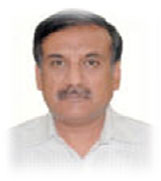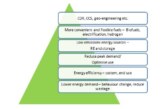 Mr. Deepak Gupta Hon’ble Secretary has infused new vitality in the ministry through his dynamism and farsightedness. Under his dynamic leadership, the renewable ministry has made rapid strides in diverse fields. He belongs to the Jharkhand Cadre 1974 batch of the Indian Administrative Service a Post-Graduate in History from St Stephan’s College and M Phil in International Relations from Jawaharlal Nehru University; he did a Masters in Public Administration from the Kennedy School, Harvard University in 1991 as a Mason Fellow.
Mr. Deepak Gupta Hon’ble Secretary has infused new vitality in the ministry through his dynamism and farsightedness. Under his dynamic leadership, the renewable ministry has made rapid strides in diverse fields. He belongs to the Jharkhand Cadre 1974 batch of the Indian Administrative Service a Post-Graduate in History from St Stephan’s College and M Phil in International Relations from Jawaharlal Nehru University; he did a Masters in Public Administration from the Kennedy School, Harvard University in 1991 as a Mason Fellow.
Prior to joining the Renewable Energy Ministry, Mr. Gupta was the Special Secretary in the Ministry of Health and Family Welfare. He also worked in the Ministry of Human Resources Development, Water Resources, Commerce and Industry, and Ministry of Textiles, besides being on assignment as Adviser with the World Health Organization (WHO) in Delhi.
After doing several District level assignments in Bihar, he came to the Government of India in 1981. Subsequently, he had various assignments in Departments of Industrial Development, Export Promotion, Human Resource Development, Water Resources in the Centre and State including a deputation to India Trade Centre, Brussels, as Adviser (Jute & Coir) during 1983-85.
Dr Arvind Kumar editor of this magazine recently interviewed the Hon’ble secretary. Excerpts from the interview are reproduced here:
FGR :How far do you agree with the statement: “India, on the one hand suffers from climate change impacts, while on the other hand, has so far done little to counter these dangers and faces the imminent challenge of how to green its industries and energy politics”?
Hon’ble Secretary : This question could better be answered by the Ministry of Environment and Forests, which is the Federal Ministry for Climate Change matters.
However, renewable are central to any mitigation strategy. India has a range of policies and programmes to help mitigate climate change, including through increasing the share of renewable in the energy mix. India initiated its concerted efforts in developing new and renewable energy technologies, much before the global surge for renewable in the wake of climate change concerns, around 3 decade ago with setting up of an exclusive Department, now the Ministry of New and Renewable Energy. Our sustained technological development efforts and policy support has started making visible impact in the national energy mix. The present installed capacity from renewable energy sources is 17 GW, which represents about 10 percent of total installed generation capacity in India. We have developed an action plan that aims at accelerating the deployment of renewable energy and targets around 100 GW of renewable power including 20 GW capacities through solar energy and also large number of off-grid and decentralized renewable energy systems by 2022.
Under National Action Plan on Climate change, Jawaharlal Nehru National Solar Mission is now under implementation. We attach great importance to harnessing solar energy and consider it paramount in nation’s transition to non- fossil fuel based economy. Our efforts have been enthusiastically responded. In addition to mitigating climate change, renewable energy applications are critical to increasing energy access through decentralised rural electrification which is especially important for India, as well as abatement of use of fossil fuel – whether diesel, or kerosene, or even coal in boiler applications.
FGR :How and up to what extent new modes of governance such as the Clean Development Mechanism (CDM) institutionalised under the Kyoto Protocol contribute to ‘greening’ India by facilitating the diffusion of renewable energy?
Hon’ble Secretary : CDM finance provides an additional revenue stream for eligible projects, and in doing so can catalyse emission reduction activities in India. In India, renewable energy projects are favourably placed to qualify as CDM projects. With around 65 percent of the 520 registered CDM projects, renewable energy constitutes largest share in the Indian CDM pipeline. Broadly, registered CDM projects totals to around 5000 MW renewable power installed capacity. CDM and the emerging carbon market in general have potential to contribute to the financial viability of renewable energy projects, although not necessarily making them fully viable. Making the CDM process easier and reducing time and transportation costs would help in more projects in decentralised mode through programmatic means.
FGR : Do you feel that, taking the wind sector as most advanced renewable energy technology into consideration, a striking gap between installed and generated capacity implies that these resources are not harnessed to their full potential?
Hon’ble Secretary : Wind energy, today, has emerged as one of the most promising renewable energy technology for generating grid connected power. A total capacity of over 12 GW, around one-fourth of the estimated wind energy potential has been established up to June 2010. It cannot be termed as striking gap, particularly in view of the fact that all most all wind energy installations are private and have been established during last 5 years only. India is now the fifth largest wind power producer in the world, after USA, Germany, Spain and China. The Ministry’s wind power programme covers survey and assessment of wind resources, facilitation of implementation of demonstration and private sector projects through various fiscal and promotional policies. We are confident of harnessing the wind energy potential even at faster growth rate.
FGR : Are there appropriate technologies and innovative policy instruments available with your Ministry to implement and diffuse renewable energy projects for electricity generation?
Hon’ble Secretary : Renewable energy development in the country has been supported by enabling environment for developing appropriate technologies and also placing a innovative policy framework. In addition to several policy based enabling provision such as feed-in tariffs, generation based incentives & depreciation benefits; renewable portfolio obligation and also proposed renewable energy certificate trading etc, Ministry’s focus is on creating a coordinated research and development framework for renewables so as to reduce costs and improve efficiencies. A large domestic manufacturing base has been established for renewable energy systems and products. JLN National Solar Mission and also research roadmaps for other renewables would make it technically feasible and cost effective to achieve the energy transition within the shortest possible time frame. A large number of projects are in co-generation mode and many projects for off grid applications including rural electrification. These are being supported by a combination of capital and interest subsidy.
FGR : Is there appropriate policy mechanism in place in the Ministry for technology transfer in order to develop and diffuse appropriate hardware and software required to get wind energy projects going?
Hon’ble Secretary : A technology transfer typically includes the transfer of the technology design as well as the transfer of the property rights necessary to reproduce the technology in a particular domestic context. A common form of property right included in a technology transfer is a patent license: a legal agreement granting permission to make or use a patented article for a limited period or in limited territory. In the Indian context, wind electric generators are being manufactured in the country by more than a dozen manufacturers through i) joint ventures or under licensed production ii) subsidiaries of foreign companies under licensed production and iii) Indian companies with their own technology. The current annual production capacity of domestic wind turbine is about 3000 MW. An indigenization level up to 50-80 percent has been achieved in machines. The trend in recent installations is moving towards better aerodynamic design; use of lighter and larger blades; higher towers; direct drive; and variable speed gearless operation using advanced power electronics typically to suit moderate wind regime and weak local grid network.
FGR : Do you think that technology transfer regards the integration of climate change concerns into conventional energy politics which requires a reorientation at policy level?
Hon’ble Secretary : Technology plays a central role in addressing climate change issues. Most transfer of technology occurs in the private sector. Channels for the transfer of technology can be market-based (including trade, foreign direct investment and technology licensing) or informal (such as imitation and the mobility of technical and managerial personnel). Indeed, restricted access to the technologies makes renewable energy costlier and is one of the barriers in harnessing renewable energy.
There is certainly a need to devise a technology transfer mechanism for un-restricted flow of climate change technologies. My prescription would be to treat renewable energy technologies as ‘global common’ in the medium term. To begin with these technologies could be placed in the public domain and joint research and development projects could be taken up between the institutions of developed and developing countries. The technology transfer costs could be fixed at no-profit level and the expenditure to be incurred in these acquisitions could be made from global funds under climate change mechanisms.
FGR : What, in your considered opinion, are the main challenges and barriers to the effective installation and dissemination of wind and solar energy technologies in India?
Hon’ble Secretary : There is no real barrier in the case of wind. As regards solar energy, as everywhere else, the main barrier is the high cost and financing, partly because of perceived technology performance uncertainty and risk. But the Solar Mission seeks to address those issues including building a strong manufacturing capacity in India incorporating latest and improving technologies.
FGR : Do you agree with the statement: “CDM in the India wind sector has some role to play as it contributes to some extent to horizontal technology diffusion”?
Hon’ble Secretary : Only around 20 percent wind installed capacity has been benefitted from CDM. To that extent it has contributed in improving financial viability of the wind energy projects. However, almost all wind energy CDM projects are unilateral. Neither CDM is proving effective as a vehicle for technology transfer nor it has been successful in reaching projects that are innovative in nature.
FGR : There is much criticism and belittling the CDM as icing on the cake that deviates resources from more additional projects. Do you subscribe to this view?
Hon’ble Secretary : Although, CDM has generated an additional revenue stream for some private companies, small and household size renewable energy projects have not been able to get the benefit of CDM because the transaction costs are too high to justify the typically small projects which could potentially benefit greatly. Further, carbon credits from CDM projects, depending upon kind of renewable energy technology increases project’s internal rate of return in the range of 1-4 percent only. This cannot be considered significant.



